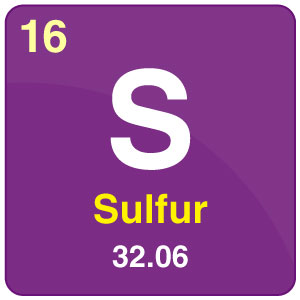
| Symbol | S |
| Atomic Number | 16 |
| Atomic Mass | 32.06 |
| Discovered by | – |

Table of Contents
Chemical Properties Of Sulfur
| Group | 16 | Melting point | 97.794°C, 208.029°F, 370.944 K |
| Period | 3 | Boiling point | 882.940°C, 1621.292°F, 1156.090 K |
| Block | p | Density (g cm−3) | 0.97 |
| Atomic number | 16 | Relative atomic mass | 32.06 |
| State at 20°C | Solid | Key isotopes | 33S, 34S |
| Electron configuration | [Ne] 3s²3p⁴ | CAS number | 7440-23-5 |
| ChemSpider ID | 4514534 | ChemSpider is a free chemical structure database | |
What is Sulfur?
-
-
-
- Sulfur (S) is an element that can never be overlooked. In the periodic table, sulfur is found in group 16. It is non-metal and is obtained as a byproduct after the production of natural gas. In colour, it is bright yellow, and it has an extremely bad odour (like rotten eggs). Outside the apparent physical characters of sulfur, humans have been consuming this element since a thousand years. Why? Because you might just find it sitting on the ground.
- Sulfur is frequently found near hot springs and volcanoes. In history, when an individual finds unadulterated elements that are freely obtainable, he uses them. Sulfur mentions can be found even in the Bible, where it is entitled brimstone.
-
-
Uses Of Sulfur
-
-
-
- Sulfur is an element that is simple to find on the ground and even simpler to discover in the periodic table. It’s just below oxygen (O) at the sixteenth position. Sulfur, when found naturally, is a yellowish colour and is frequently found as crystal. Sulfur is non-reactive at normal temperatures.
- Sulfur plays a key role in the body and is necessary for the synthesis of some key proteins. Sulfur, for example, is needed for the glutathione synthesis, which acts as a potent antioxidant to protect your cells from damage.
- While sulfur consumed naturally in food is important to the body, there is scant evidence that it is helpful to take sulphur supplements.
- Sulfur is an ingredient approved by the FDA for use in dandruff products of over-the-counter nature. It often comes in combination with salicylic acid. There is, however, limited evidence to support that use.
- Osteoarthritis is often treated with the use of sulfur supplements. MSM may be of some benefit to those with knee osteoarthritis.
- It is possible that sulfur is safe when used topically. Researchers have safely used products containing sulfur in concentrations up to 10% in clinical studies lasting up to eight weeks.
-
-
Interesting Facts about Sulfur
-
-
-
- Sulfur makes up almost 3 per cent of the Earth’s surface.
- When sulfur burns it creates a toxic gas called sulfur dioxide. This gas was once used in New York to fumigate buildings which harbor infectious diseases.
- Sulfur is also thought to have been a part of the ‘Greek Fire,’ a flamethrower-like device used by the Byzantine Empire.
- The sulfur obtained from molten sulfur is called monoclinic sulfur while rhombic sulfur is called sulfur obtained from crystallizing a solution. Both forms are composed of rings S8. The distinction between the forms is how they organize the rings inside a crystal.
- There is no smell of pure sulfur but many of its compounds stink! Sulfur compounds called mercaptans, for example, give skunks their gruesome smell. Rotten eggs (and most stink bombs) get their distinctive hydrogen sulfide, H2S, flavouring.
- Sulfur occurs in many allotropes, both crystalline and amorphous. The most common form is bright, orthorhombic alpha-sulphur, containing puckered S8 rings.
- Sulfur is multivalent and combines almost all other elements, with valence 2, 4, or 6. Hydrogen sulfide ( H2S) is the best-known sulphur compound. This is a poisonous gas smelling like rotten eggs; the odour is used in stink bombs, all of which emit a small amount of hydrogen sulfide.
- The principal industrial use of sulfur in the manufacture of sulfuric acid ( H2SO4) is as a reactant. Sulfuric acid is the number one bulk chemical in the developed world which is needed for automotive use in large quantities in lead-acid batteries.
-
-
Frequently Asked Questions – FAQs
What is sulfur used for?
Sulfur is used as a fungicide and in black gunpowder for the vulcanisation of natural rubber. Nevertheless, most sulfur is used in sulfuric acid manufacturing, which is probably the most important chemical produced by Western civilisations.
What are 3 common uses of sulfur?
It is used for making car batteries, fertilizer, oil refining, water processing, and mineral extraction. Other applications for sulfur-based chemicals include rubber vulcanization, bleaching paper, and product making such as cement, detergents, and pesticides. And some gunpowder.
Is Sulphur good for skin?
Sulfur helps to dry out the skin’s surface and help absorb excess oil (sebum) which can lead and acne breakouts. To help unblock your pores it also dries out dead skin cells. Some products contain sulfur along with other ingredients used to fight acne, such as resorcinol.
How can I get sulfur naturally?
Sulfur is recovered from natural gas , coal, crude oil, and other sources such as flue dust and gasses from metal sulfide ores refining. Elemental sulfur is obtained in various forms including sulfur flowers, fine crystalline powder and roll sulfur.
Does the body need sulfur?
Sulfur, in the human body, is the third most abundant chemical. The factor is also present in a variety of foods, including garlic , onions, eggs and foods high in proteins. Sulfur is necessary for the synthesis of the essential cysteine and methionine amino acids.

Comments